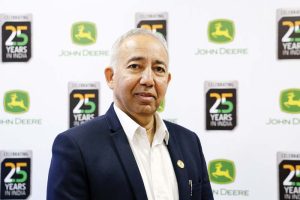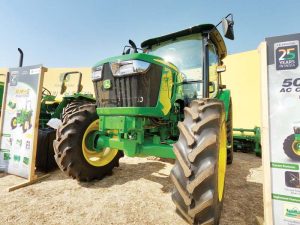In an Industry Talk session, Prateek Pardeshi speaks to Shailendra Jagtap, Managing Director at John Deere India on the segment outlook and export potential.
Q. How evolved is the DNA of the new range and what makes a flagship?
A. Yes, all of them are flagship products. We have a range of tractors starting from 20-75 hp in India, serving the Indian farmers. We also sell these products to more than 110 countries. Another product, our 5M tractor is ‘Made in India’. It caters to 75-130 hp with a host of advanced tech. We are manufacturing this product for export to the USA, EU and Japan.
Q. John Deere also launched the 3.0 range in 2021. How is the sales performance?
A. John Deere in India is known for power and technology. We want to develop innovations which are led by the customer. We want to deliver on the basis of what the customer needs. We started it a few years ago and developed it, naming it the 3.0 range. In 3.0 we bought a couple of technologies. We are now focusing on the Mechanical Front-Wheel Drive (MFWD) tractor, and power reverse tractors. MFWD tractor improves the quality of work, and is accepted overall in the country. It is a space where we lead in India. Power reverse technology is used for loaders and other applications, so the customer need not go back and forth and power reversing makes it easier for the operator. Further, we also introduced AC Cabs in India. We are delivering auto track which is required for row planting as amongst the innovations under the 3.0 range.
Q. How significant are the developments for compliance to emission norms across markets?
A. The emission norms are set by the government, and while delivering the tractor if we are exporting it then we give the tractor up to TREM 5 since Europe is already there. India on the other hand has made a decision that for 50 hp and above, India will go for BSIV.
Q. Give us some insights on operational sustainability?
A. In manufacturing we have taken different approaches to deal sustainability, the priority being the utilization of renewable energy. We are currently at 35 per cent renewable energy utilization, comprising wind and solar together. Second, we have a program where we are reducing the use of wood. We also re-utilize the water, and our facilities are known for zero-discharge facilities. All water we use here is treated and re-utilised in both our facilities in Pune and Dewas, so that is how we are working on reducing the carbon footprint in manufacturing. All our manufacturing processes are also closely monitored where we focus efficiency on power consumption which can be reduced.
Q. The global report of John Deere 2023 stated that the Asian market is under performing on agricultural and turf products relatively. What measures are you taking to counter this?
A. The Asian market consists of China, and SouthEast Asia. We are noticing that the Indian market is on a similar front as it was last year, and some of the markets do see softening. As a result, the Asian market dipped to ~five per cent. But when we look at the quantum and size of the market the pace is significant. We intend to deliver value to customers through our power and technology and that is how we are trying to get to the market and see if you can get more customers.
Q. How are you placed in the Indian market and where do you lead here?
A. We are leaders in the 50 hp and above categories, and are better placed in 45 hp and above categories.
Q. How are customers adapted to IoT solutions?
A. When we talk about customer POV, we have our ‘Anubhuti App’ where each farmer who is buying our tractor is downloading that app. The app provides a lot of information regarding implements and applications. Through ‘John Deere Financial’ tracking all financials such as loans, EMIs, etc is made possible. These two apps are widely used by our customer base. They get a sense of transparency in transactions finding it easy to operate.
Q. In the global market John Deere has introduced the CEV range. Do we expect them to turn to India?
A. We are continuously working on opportunities in India. Still, in near future, we don’t see John Deere entering into the construction business, but in the far future if the opportunity is there we may.
Q. Looking at the 25 year journey what is the future road map for India?
A. More than our strategy, it is the customer which drives it. There are two factors, one is environmental sustainability and soil sustainability and that is how we can attain sustainable agricultural practices. John Deere is working on both aspects. We are working on a product which can really reduce carbon footprint, and we are focusing on precision agriculture, planting, spraying, and adequate use of fertilizer, which will in turn reduce soil erosion. Globally, we are targeting this technology and as per the customer need, John Deere has the capacity to deliver this technology in India as well.




















